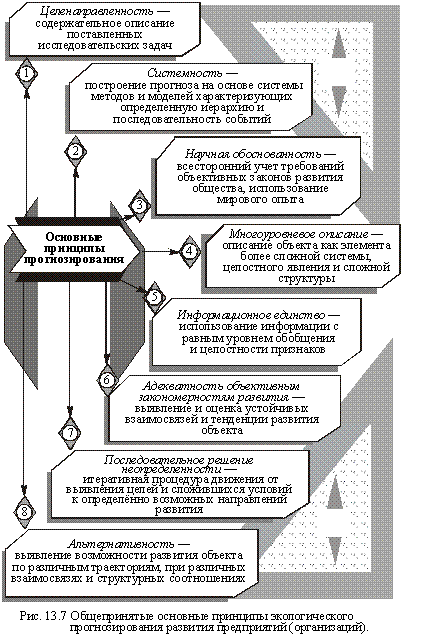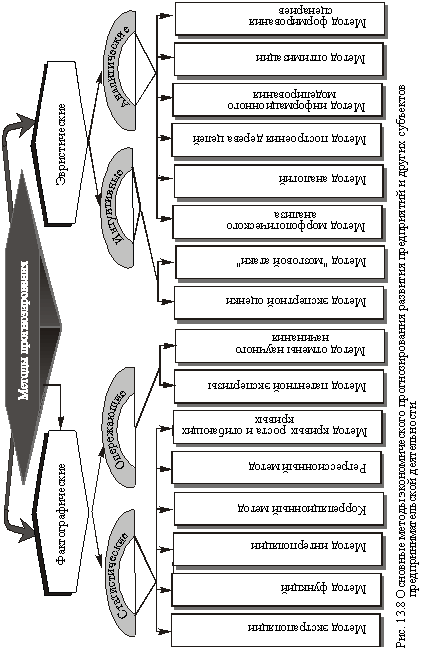home
 Economy Economy
 Economy of the enterprise - Pokropivny SF Economy of the enterprise - Pokropivny SF
|
Economy of the enterprise - Pokropivny SF
13.2. Forecasting the development of enterprises
The essence and principles of forecasting
The prognosis (from gr. Prognosis - foresight) is an attempt to determine the state of a phenomenon or process in the future. The process of making (developing) a forecast is called forecasting. Forecasting the development (state) of an enterprise or organization is a scientific justification for possible quantitative and qualitative changes in its (its) state (level of development in general, individual activities) in the future, as well as alternative ways and timescales for achieving the expected state.
The forecasting process is always based on certain principles. The main ones are shown in Fig. 13.7.
Possible methods of forecasting
The system of forecasting is formed by fixing possible and structured by certain criteria methods for developing the forecasting of the future state of a particular economic entity. Depending on the sources of information, the technology of its processing and the results obtained, the ecological methods of forecasting are divided into two relatively large groups: 1) factographic ; 2) heuristic (Figure 13.8).
Factographic methods of forecasting are based on the use of actual materials that characterize in detail the changes in time of the entire aggregate or individual characteristics (indicators) of the prediction object. The main methods in this group are methods of extrapolation, functions, correlation-regressive models.
The method of extrapolation is one of the main ones for forecasting the development of complex production systems: it is based on the assumption that the factors determining the development of the research object are unchanged. In this connection, the essence of the method of extrapolation consists in extending the laws of the development of an object in the past to its future.
The method of functions refers to the mathematical-statistical prediction methods, which are based on the use of so-called autocorrelation functions (autocorrelation is an expression of the mutual connection between neighboring terms of the time series). The prediction process using autocorrelation functions consists of two consecutive actions. First, the forecasting problem is formulated and the criteria for its solution are determined, and then, using the time series that reflects the process of development of the parameters of the production system in time, determine the predicted value for the prospective period, provided that the mean-square prediction errors are minimized.


The methods of correlation and regression models are also relatively widely used in economic forecasting.
Forecasting using correlation models (methods) consists in the search for mathematical formulas that characterize the statistical relationship of one indicator with another (pair correlation) or with a group of others (multiple correlation). An obligatory condition for the possibility and expediency of using such methods is to establish the degree of reliability of correlation formulas based on a logical analysis of the sufficiency of a statistical sample (data masiv).
The form of the relationship between the predicted phenomena and other phenomena and processes can be depicted as a regression equation of the type y = f ( x 1, x 2, ..., xn ). The value of the predicted indicator is determined by the way of substituting in such an equation the values of attributes (factors) and estimating the expected average value of the effective characteristic.
In the process of solving correlation and regression solutions, a search is made for numerical values of the parameters of the initial dependencies, which can be determined using the method of least squares. The essence of the latter is to minimize the sum of the quadratic deviations by the corresponding quantities calculated from the selected communication levels.
Heuristic methods of forecasting provide for the implementation of predictive developments using logical techniques and methodological rules of theoretical research. Specific methods of forecasting this group cover two subgroups - intuitive and analytical. Among the main methods of the first subgroup are the methods of peer review and brainstorming, and the second - the methods of morphological analysis of the construction of the "goal tree", information modeling, optimization.
In the absence of sufficient statistical information or its unacceptability for forecasting, the method of peer review is compulsorily used . It is based on the way to collect the necessary information through questionnaires. In this case, the expert evaluation should be designed in such a way that it is possible to obtain:
- Quantitatively unambiguous answers to the proposed questions;
- Formalized information on the nature of the sources of reasoning, the degree of influence of each source on the expert's response;
- Quantified by an expert assessment of the level of his knowledge of the subject, proposed for analysis and conclusions.
Two approaches to the use of the forecasting method under consideration are known and applied: application of individual and group estimates. Individual assessments consist in the fact that each expert gives an independent assessment in the form of an interview or an analytical note. Group assessments are based on the collective work of experts involved in the projected evaluation of specific economic processes.
The method of " brainstorming " is a variation of the method of group expert assessments and is reduced to creative cooperation of a certain group of experts - specialists in solving the task - through discussions. Participants in the debate should adhere to two rules: the first - to avoid criticism and ironic reviews about the statements made by opponents; The second is not to deny new ideas, no matter how absurd they may seem from the point of view of their possible realization in modern conditions.
The method of morphological analysis is based on the use of combinatorics, that is, studies of all possible options based on the pattern of construction (morphology) of the studied and analyzed object of research (forecasting). Forecast assessment of the development of the enterprise (organization) is carried out by combining possible options for the future state of the facility.
The method of constructing a "goal tree" is used in forecasting with the aim of breaking down the main tasks into sub-tasks and creating a system of "weighted" by expert estimates of links. In the forecasting model, mutual interaction matrices and graph theory are widely used.
A specific method of forecasting is the method of information modeling . It is based on the fact that the characteristic features of mass information flows create the conditions for forecasting the development of specific objects on the basis of such information sources that contain the necessary, logically ordered documents in a certain sequence.
One of these methods of forecasting is the method of optimizing the series of parameters of specific objects under investigation based on the analysis of the maximum possible number of factors associated with production and financial and economic indicators, taking into account the degree of interaction, these factors.
Other methods of forecasting the activity of enterprises and organizations are possible. In the group of facts, one can name, for example, advanced methods, which, in particular, belong to the methods of patent examination . In the subgroup of statistical methods, forecasting methods such as interpolation methods , growth curves and curve envelopes are also possible , and in the analytical subgroup, the analogy method , the formation of special scenarios, and so on.


Comments
When commenting on, remember that the content and tone of your message can hurt the feelings of real people, show respect and tolerance to your interlocutors even if you do not share their opinion, your behavior in the conditions of freedom of expression and anonymity provided by the Internet, changes Not only virtual, but also the real world. All comments are hidden from the index, spam is controlled.